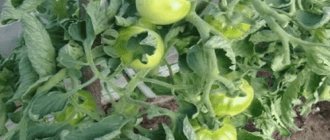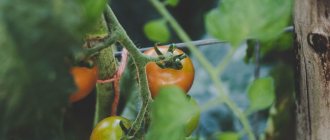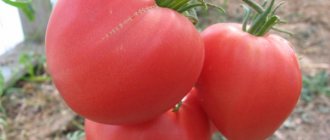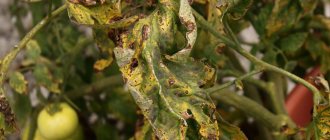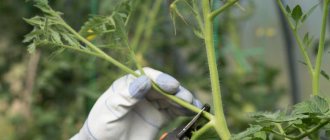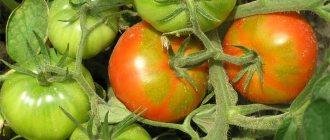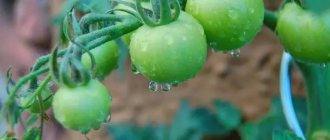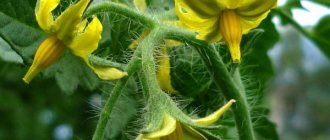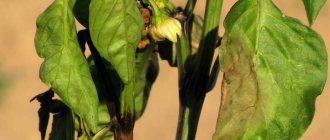OgorodGuruCom
Tips and tricks for gardeners
Popular
Descriptions of Lorch potatoes - what kind of variety is this?
Home › Vegetables › Why tomatoes don’t ripen in a greenhouse for a long time
Getting a rich and high-quality harvest is the most important task of every vegetable grower. But to achieve this goal, it is necessary to make some efforts. Tomatoes do not always have time to ripen on time, even if they are grown indoors. What to do if the tomatoes do not turn red in the greenhouse, what the owner of the plantings should do, how to speed up the ripening of the vegetable crop will be described in detail below.
What to do to help tomatoes
The main reason for poor reddening of the crop is the lack of proper climatic conditions and characteristics of the variety. Hybrids have the most uniform ripening and coloring of tomatoes, and therefore a lot depends on the correct choice of varieties.
Experienced gardeners use a number of proven methods to speed up ripening; there is nothing complicated in such procedures:
- ensuring good microclimatic conditions in the greenhouse. Tomatoes must receive sufficient sunlight. Excess leaves are removed and the shoots are turned so that they are not in the shade. To fix the desired position of the plant, it is recommended to tie it up;
- For foliar feeding, iodine is used, the product is diluted at the rate of 35 drops per 10 liter bucket of water. The solution is used to spray the leaves. After several feeding sessions, the ripening of tomatoes accelerates;
- removal of excess inflorescences, leaves and stepsons. The top part of the tomato bush is pinched or trimmed to stop the growth of new shoots. Thanks to this procedure, the consumption of nutrients is reduced. Without removing excess shoots, the crop is small in size and does not always have time to ripen;
- the use of alcohol injections, this technique also significantly accelerates the maturation process. Here you will need to use a syringe and vodka; alcohol consumption per tomato is 0.5 ml. After 14 days, complete reddening of the crop is observed. It is worth noting that the taste of tomatoes does not suffer from this;
- if sudden cold weather occurs and it is not possible to maintain the microclimate necessary for tomatoes in the greenhouse, then it is recommended to dig up the bushes and move them to a more suitable place; the supply of nutritional components should be enough to complete ripening;
- Often tomatoes do not turn red for a long time due to late blight; diseased plants may not ripen at all; on the contrary, they turn black. Garlic solution or other means are used as preventive measures.
Chemical and mechanical methods
When a vegetable crop delays the ripening and reddening of fruits, they resort to the use of additional accelerators.
Drugs
Among the effective means for processing tomatoes in order to accelerate their ripening is the drug “Dozrevatel”. Processing rules:
- provides for one-time use for foliar spraying;
- dosage – 7 ml per 10 liters of water;
- application rate – 50 ml per bush;
- the solution is used immediately after preparation and cannot be stored;
- has an effect on bulk tomatoes with a glossy surface, ready to turn red.
Prevention
The main preventive measure will be the creation of an optimal microclimate in the greenhouse. Tomatoes ripen well in moist soil, but the plants do not like high indoor humidity at all.
Due to lack of light, certain problems with the ripening of tomatoes also arise, and therefore it is necessary to create suitable conditions in a timely manner. An alternative option is auxiliary lighting devices, thanks to which you can increase productivity.
The following activities include caring for greenhouse crops so that they feel good:
- periodic removal of weeds;
- ensuring regular watering;
- carrying out stepsoning;
- gartering as needed;
- application of mineral and organic fertilizers.
Helpful advice. To prevent the skins of tomatoes from starting to crack, it is recommended to water them in several stages.
You can protect plants from a number of ailments (gray rot, root rot, mosaic, brown spot, late blight, etc.) by systematically spraying plants, correctly selecting friendly tomato varieties and controlling soil moisture.
Factors affecting the growth rate of tomatoes in a greenhouse
In a normal situation, tomatoes, having formed an ovary, gain fruit volume within a month, after which they go through the ripening stage for 2-3 weeks. That is, in 40–55 days the tomato should reach marketable condition.
For this he needs:
- full lighting , which even in a greenhouse should be as sunny as possible, but if this is not possible, it must be significantly supplemented with artificial lighting;
- correct temperature regime , which should not go beyond +15...+35 °C with an optimal average temperature of +25 °C;
- sufficient watering while maintaining dry air;
- the distance between tomato bushes is at least half a meter, eliminating the density of plantings;
- with timely removal of excess leaves from the plant .
Did you know? During its short century of existence as a cultivated plant, which lasts less than 500 years,
the fruits of the tomato, which barely reached a weight of 1 g, turned into kilograms and more.
How to feed tomatoes
To obtain a bountiful harvest, plants must be fed in a timely manner. After the seedlings are planted, experts advise using complex fertilizers with precise dosages of components such as potassium, nitrogen and phosphorus.
During the beginning of flowering, a special fertilizer for tomatoes “Sudarushka” is used. It does not contain chlorine, but it contains the entire complex of useful substances necessary for the plant.
When the ovaries begin to form, you need to carry out foliar feeding. Many gardeners use wood ash for this purpose. Or rather, a solution is prepared based on it according to the following recipe:
- ash - 2 cups;
- hot water – 2 liters;
- mix thoroughly and leave for 48 hours to infuse;
- drain the sediment, add water to make 10 liters.
The resulting solution is used to treat shrubs in the evening or on a cloudy day to spray the leaves. They must be dry.
When fruiting begins, superphosphate is used for feeding. The product in the amount of two tablespoons is diluted in water - 10 liters, potassium humate is also added - 1 tablespoon. Used as root feeding at the rate of 1 liter per plant.
How to speed up the ripening process of tomatoes
The key to large and juicy fruits is feeding. Many summer residents strive to make their harvest as environmentally friendly as possible, so they do not use chemicals. How can you feed the plants in this case?
Effective fertilizers for tomatoes:
- Iodine-ash fertilizer . Pour 2 liters of crushed ash into a bucket and pour 5 liters of boiling water. When the mixture has cooled, add another 5 liters of settled water to the container. The bucket is covered and placed in the shade. After a week, the infusion of ash is poured into another container, into which 20 ml of 5% iodine and 10 g of boric acid are then added. The resulting concentrate must be diluted with settled water in a ratio of 1:9. One bush will need 0.8-1 liters of solution.
- Superphosphate extract. Pour 100 g of granulated phosphate into an enamel bowl and pour 5 cups of boiling water over it. Set aside the mixture for one day, stirring it occasionally to completely dissolve the granules. After a day, drain the hood, 20 tbsp. l. dilute the product with 3 liters of water. The resulting concentrate is diluted in a ratio of 3/4 cup to 1 bucket of water. One bush will need 1 liter of solution.
Useful tips
Based on the observations of gardeners, plants experience a sharp activation of all forces if a mechanical threat arises:
- you need to make a through cut in the stem part or tighten it slightly using copper wire. Due to the resulting deficiency of nutritional components, rapid reddening of tomatoes and their ripening are stimulated;
- You can also use a rather harsh method, which consists of slightly pulling the bush out of the ground until the faint crackling sound of exploding roots is heard. A small break of adventitious roots leads to a limitation in the supply of nutritional components to the bush. This will force the tomato to activate its forces to ripen the crop;
- Some gardeners, using a toothpick, make several pricks in the area of the stalk of a green tomato. This product serves to stimulate pigmentation;
- Another technique is a more humane remedy. You need to take a ripe tomato, put it in a plastic bag and put it on the brush where there are green tomatoes. The opening of the bag is tied with a soft fabric ribbon. A few days later, synchronous reddening of the unripe crop begins.
Traditional methods
Vodka injection of tomatoes.
Let's take a look at the most common ones:
- take a toothpick and pierce the tomato in several places near the stalk to a depth of about 3 cm . The punctures will heal quickly, and the tomato will take on a red tint;
- using a syringe with a thin needle, inject 0.5 ml of vodka . This injection promotes rapid ripening of fruits.
Cold weather
The most common reason for the long ripening of tomatoes is low air temperature and cloudy rainy weather. Tomato is a heat-loving plant. During the period of fruit ripening, the optimal daytime temperature is 25°C during the day, and 16-19°C at night. A slight decrease of a few degrees will not affect the rate of ripening in any way. But sudden changes in temperature are stressful for tomatoes, as a result of which fruit formation slows down and growth is inhibited. For example, at temperatures below 15°C, new flower clusters do not appear, and formed fruits do not ripen. Too high a temperature – 33-35°C – also has a negative effect on plants: the process of photosynthesis slows down, pollen becomes less “active”, and flowers fall off.
The soil temperature should also be more or less stable, within 16-24°C. In cold soil, nutrients are poorly absorbed, and the bush cannot fully develop.
What to do
First, mulch the soil in the tomato beds both in the greenhouse and in the open ground. This will help reduce the frequency of watering and stabilize the temperature of the earth: it heats up slowly and cools down slowly, and does not overheat under the scorching rays of the sun.
Secondly, greenhouses and hotbeds should be opened as much as possible in hot weather so that the air does not overheat. And during cold weather, the windows and doors of greenhouses should be closed before sunset to conserve heat. Cover plantings in open ground with spunbond at night, which will help reduce the difference between day and night temperatures.
Lack of light
Tomato is very demanding of light. In poor lighting conditions, the shoots become elongated, develop poorly, fruiting is delayed, and the taste and quality of the fruit deteriorate. Often, a lack of lighting occurs when bushes are planted in dense areas, which is especially common in a greenhouse. This also threatens the emergence of various diseases, since thickened bushes are poorly ventilated.
What to do
Regularly remove stepsons, as well as excess leaves that are in the shade and interfere with air circulation. First of all, you should remove the lower leaves up to the first cluster on the main shoot. Then you can cut off the leaves on the side shoots, directed into the bush and located below the first brush. In one day, it is enough to remove only a few leaves from the bush, otherwise the plant will experience severe stress. This work should be carried out in the first half of the day so that the sections dry in the sun. However, when removing leaves, it is also important not to overdo it: at least two leaves should remain above each bunch of tomatoes, which will provide the fruit with nutrition.
- What to do with tomato leaves - cut or leave on the bush?
Do I need to trim the leaves of a tomato and what will it do? An experienced tomato grower discusses controversial practices.
Proper plant care
It will take a lot of strength from the plant and a huge number of young shoots.
Most of the shoots that do not have flower ovaries need to be removed.
- Each branch will draw a lot of moisture , thereby preventing the fruits from ripening. By drawing out the juices from the fruit, the leaves will be strong and incredibly green, but the fruits will be dull and small. This is due to the lack of the required amount of nutrients.
- If the ripening process stops, the stalk will be green , like the fruits themselves.
- In some areas the surface may begin to turn gray . Experienced gardeners know the need to regularly inspect plants for excess shoots. They will prevent the fruits from ripening and reduce the amount of harvest.
- Fresh flower stalks should be removed if the ovary has formed late and the fruits clearly do not have time to ripen.
